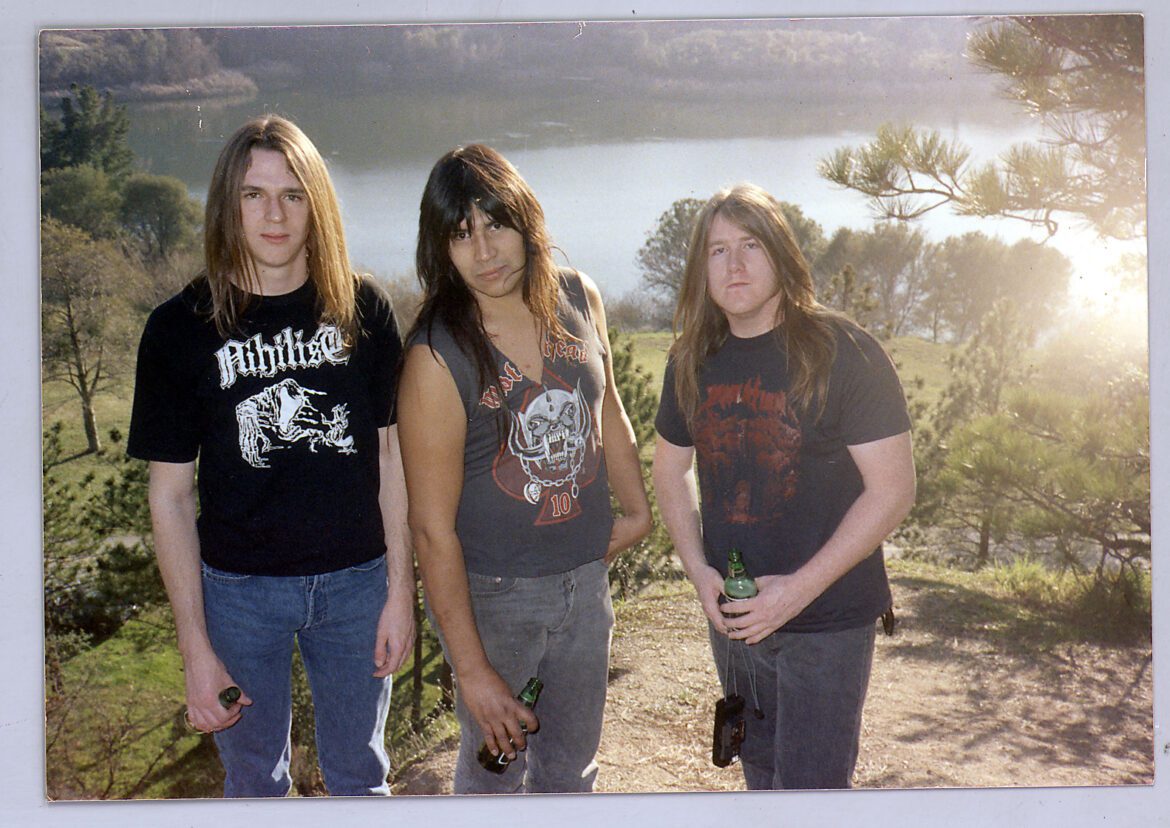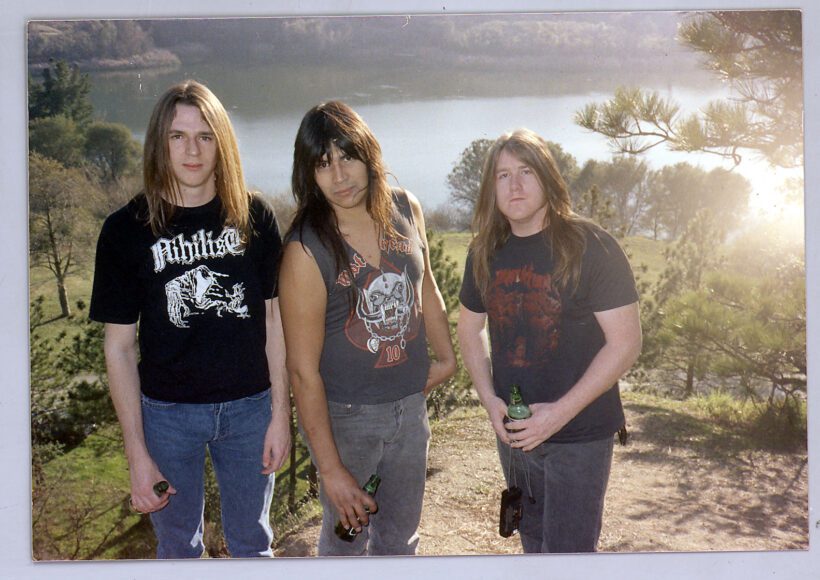
On Friday, December 6, Autopsy will perform their seminal death metal classic, Severed Survival, in its entirety for their first-ever Denver appearance at Decibel Magazine Metal & Beer Fest at Summit. Tickets for this 35th anniversary exclusive performance are still available, but are moving fast.
In between acquiring tickets and waiting for your chance sample the finest craft beer on earth some during the So-cal legends’ landmark set, get further hyped by digging into the full Severed Survival Hall of Fame from Decibel’s September 2015 issue. The following story features lengthy interviews conducted in early 2015 with every member of Autopsy who performed on the record.
All kinds of heavy shit happened in 1989. The Soviet Union crumbled, Salman Rushdie pissed off the Grand Iranian Poobah, the Exxon Valdez spilled black gold all over pristine Alaskan coastline, Pope John Paul II evacuated holy bowels in Africa, and Ron Hextall scored a goal in the NHL playoffs. Some other crazy stuff happened, too, but for sake of the Hall of Fame, Autopsy released debut album, Severed Survival. To compare Autopsy to anything else that happened on a global scale in 1989 is perhaps hyperbole, but for us—death metal’s unending army—Severed Survival is a major milestone. A pillar, however foul, of significance. As the first album after Death exited drummer Chris Reifert posthaste, Autopsy’s debut ruled the underground.
From the moment Severed Survival kicks off with “Charred Remains”, it’s pretty much over. Whereas most death metal by 1989/1990 was moving into precision and professionalism—two Ps that cause lead medical examiner Reifert to cough uncontrollably—Autopsy were unapologetically not. They wanted to keep death metal’s ugliest and most destitute origins intact. Thrash had matured into endorsements, TV spots, and major labeldom. Severed Survival was the opposite of thrash. “Gasping for Air,” “Ridden with Disease” and “Critical Madness” aren’t songs of change. They aren’t designed to inspire for the greater good of humankind. Autopsy was almost-engineered to rot, to corrupt, to invoke fear. To be sick and heavy with no regard for policy or decrees.
That Severed Survival inspired a legion of bands—mostly of Swedish origin—isn’t really a surprise. It was a musical horror movie, B-rated, blood-thirsty, and sexually offensive. Autopsy appealed to the primal urge. The switch we’ve long ago turned off. Whether to strum a super-distorted electric guitar or to eat barely-cooked meat like a Neanderthal, “Pagan Saviour,” “Service for a Vacant Coffin” and “Impending Dread” made us feel alive again. It made us want to take fire and destroy with it. Severed Survival, in its minimalist trappings and beginner’s luck, embodied death metal, the genre in its entirety. Twenty-six years later, it still remains as pivotal, barbaric, and necessary as the day Peaceville barfed it—with two covers no less—out to an unsuspecting but willingly influenced public.
Back in 2009, we questioned Autopsy’s permanent addition to the Hall. With animal offal every-fuckin’-where, wet burrito farts abound, permanent (and debilitating) halitosis, clips of fungi-invested toenails on the kitchen table, and unwashed groin perfume permeating everything in sight (Queensrÿche, Bad Religion, and Failure weren’t too pleased we didn’t inform them they’d be bunking with death metal’s deadliest funk), we still question our judgment in welcoming Autopsy. Well, turns out six years of Mental Funeral parading around in soiled underwear, reefer smoke, and broken Trouble riffs hasn’t totally turned us off to California’s greatest polluter. With the nastiest zit popped and longest Aztec two-step on record enjoyed, we open the stalls of the Hall to Autopsy’s debut album, Severed Survival. Turns out two wrongs do make a right. In our book of truths, at least.
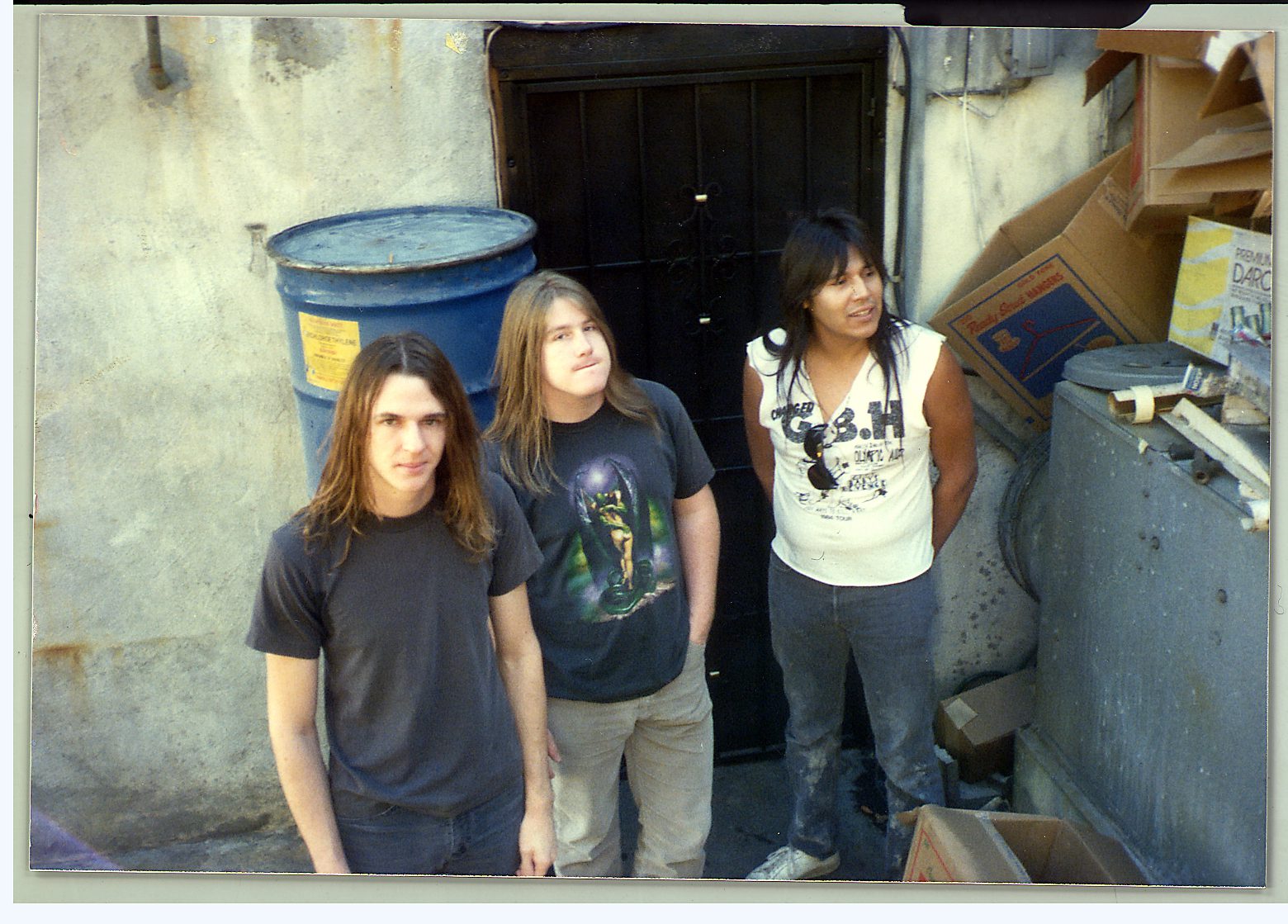
In the late ’80s, the Bay Area scene was very active. Where did Autopsy fit in the Bay Area scene?
Eric Cutler: We didn’t fit in. The Bay Area was about thrash and we were about doomy death metal.
Danny Coralles: Wherever we wanted. Back then you didn’t think that way, you just concerned yourself with making your band the sickest on the planet. We were up against the world as far as we were concerned.
Chris Reifert: I’d say we fit snugly in the outcast bracket. [Laughs] The scene around here was pretty well thrash-dominated and death metal was something that strictly weirdos played. Being weirdos ourselves, it worked out nicely.
Steve DiGiorgio: Well, it’s cool how things developed back then. Chuck [Schuldiner] and Chris were in Death together, as I’m sure you know. They became friends with Sadus. I think they [Chuck and Chris as Death] called us up and said, “Hey, we like your demo. Let’s hang out and have a beer.” [Laughs] I remember the call. Chuck called up and said he was in a band called Death. I was like, “What?! Are you serious?” Turned out to be very important call for our friendship. Chuck would later put me on the map. We had a bigger circle of people we’d hang out with though, two whom were my buddies from high school named Eric. As in Eric Cutler and Eric Eigard. The point of this is: after Death released Scream Bloody Gore, Chuck had enough of being the hobo with his life on a stick. He abruptly moved back to Florida, where there was more comfort with his family. Plus, the whole Florida death metal scene was germinating. The Bay Area scene was way more advanced. Anyway, Chuck really just left without telling anyone. The result of this was Chris being dumbfounded. Chuck was telling Chris to move to Florida to be in the band. Chris had just graduated high school. He knew to stay put. So, this hang-out pack was gone. Chris was alone. He had us, but his routine was gone. No more band practice. No more writing sessions. I had Sadus things to do, so I couldn’t jam with him. Actually, that’s when I introduced Chris to the two Erics. They had similar interests. Like smoking weed! [Laughs] I knew they’d hit it off as pals. They were all high-level inhalers who were really into extreme metal. Plus, one was a guitar player and one was a bass player. It was a no-brainer. They formed Autopsy together.
Why do you think you moved in the opposite direction—more underground, uglier, deathier—from most Bay Area bands? The musical bond you formed with Sadus and Hexx was more powerful than, say, Testament or Metallica.
Cutler: We played the music we wanted to listen to that no one else was doing. We just wanted to be heavy and sick. We were friends with Sadus and Hexx and played shows together. The styles of music were never a factor.
Coralles: Influence, we played what we loved and that includes a lot of heavy shit. We never tried to move in an opposite direction. We were just doing our thing. As far as Sadus and Hexx, I think it’s just the proximity effect. At one time all of Autopsy lived in Antioch, California. That’s where the Sadudes are from. I recall hanging out with Hexx at their bad side of Oakland practice pad. Your tires might be stolen off your car when you’d return, but Hexx was amazing. Hella Mickey’s Big Mouths!
Reifert: We seemed to gig and party together quite a bit. We all got along great and had lots of fun hanging out and jamming. We were all quite different from what was going on in the local scene and maybe for that reason, we all bonded together. On a personal level, I just liked heavy, doomy, crushing death metal and we went for that whether it made us popular or just plain freaks.
DiGiorgio: Things were totally underground back then. There was no structure. No support of any kind. Really primitive.
What were the demo days like?
Reifert: We were making noise and recording in a little studio right down the street from Danny’s apartment. It was exciting to hear our wacky ideas on recorded tape. The demos got our name out there, got us signed, and helped us get in contact with lots of cool bands who shared our love of horrifying music. Good times indeed!
Coralles: Your classic drunken, stoned, debauchery! Playing crazy house-kegger parties that got out of control, and discovering amazing new bands!
Cutler: Good times. Everyone traded tapes in those days and that’s how you discovered bands. No Internet and no downloading!
DiGiorgio: Well, when Chuck and Chris split you could tell which one was into brutal death metal. Chuck was into Watchtower and European power metal. Chris was really into Trouble, Black Sabbath, old Corrosion of Conformity, which was a slab of brutality. The point is: Chris was clearly the caveman bashing the drums, spewing lyrics. It didn’t matter if it was out of tune or off time, Chris was raging. Looking back on Autopsy, if you took away all that it wouldn’t be as special. They needed all that ugly stuff.
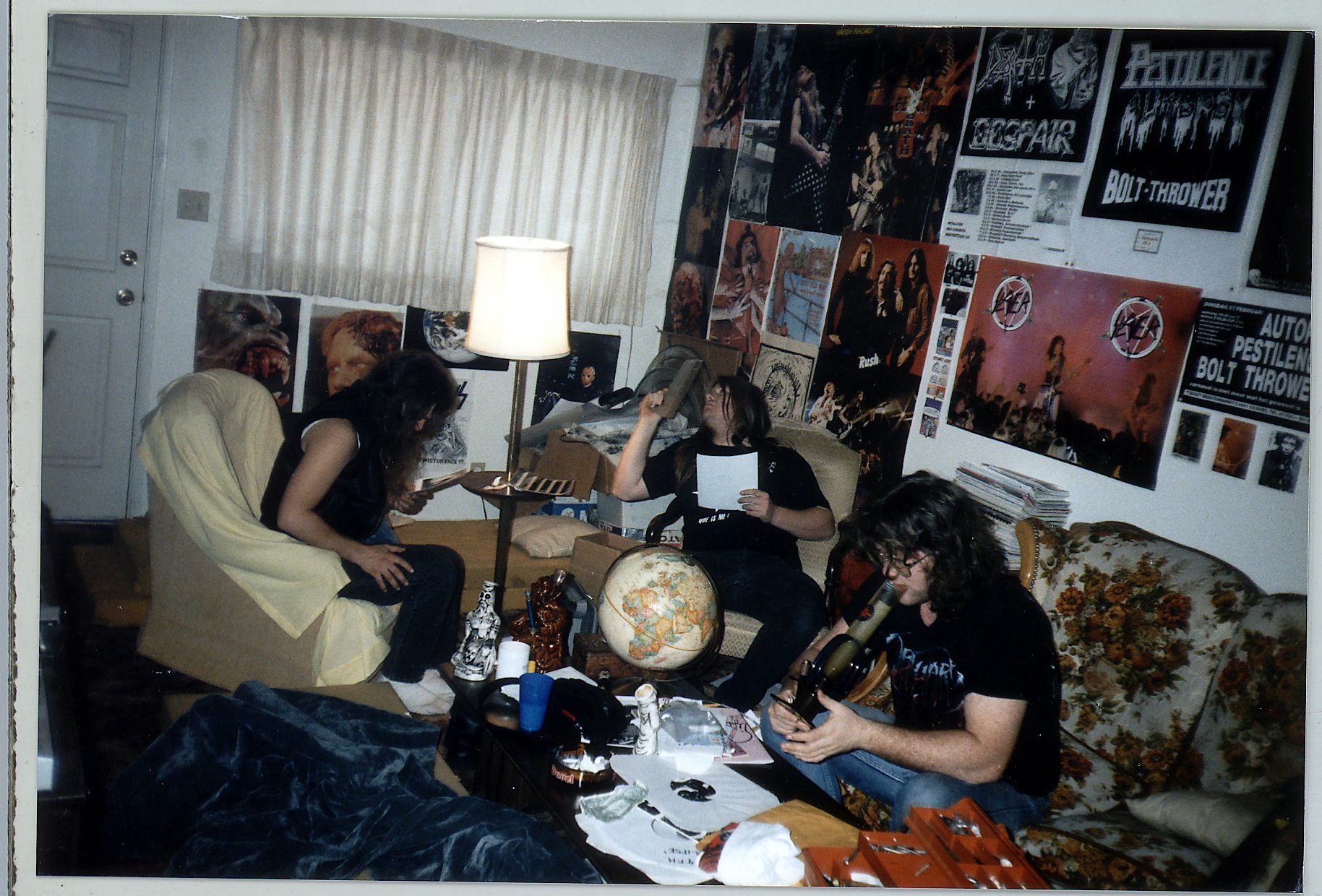
Were you actively looking for a label deal? Not sure if it was perceptionally cooler back then to DIY everything instead of having a label in a supporting role.
Coralles: I was just trying to keep up and contribute musically.
Cutler: We wanted a label deal, but we didn’t want to be ripped off. We heard horror stories about some labels and just wanted a fair deal.
Reifert: When we made the demos, we weren’t actively looking for a label, though of course we wanted to get a record out. That’s the ultimate goal of being in a band, right? I do remember one weird, unheard of label courting us briefly, but it looked really dicey and we passed. Looking back, that was a good decision.
Do you recall how the Peaceville deal came to be?
Coralles: Hammy [Paul Halmshaw] liked the demos. A wise man!
Cutler: I think Chris remembers this better, but I believe Carcass gave our demo to Hammy.
Reifert: I do remember that pretty well. I had gotten in touch with Jeff Walker from Carcass somehow. One of us must have written the other a letter. I don’t recall who reached out to whom, but we ended up trading demos with each other. Jeff told Hammy from Peaceville about us and Hammy wrote to us and offered a deal. Peaceville was a new label, but it seemed cool and Hammy seemed really friendly and it all just clicked. Hard to believe that was 27 years ago and we’re still on Peaceville!
What do you remember about the songwriting sessions? “Service for a Vacant Coffin,” “Disembowel,” “Gasping for Air,” “Pagan Saviour,” “Impending Dread” and “Severed Survival” were new to Autopsy.
Cutler: Get really stoned and playing guitar! Bong rips and bowl loads!
Coralles: Since the recording of Severed was like my seventh day in the band, Chris and Eric had the basic song riffs down, so I have this chunk of the song where I get to play lead. For me I can’t just play something complementary, but it must be a crucial part to the song. I tried to make it so “Severed” wouldn’t be the same song without that solo, same as “Gasping for Air” wouldn’t be the same without Eric’s classic solo. I would say on Severed the leads are part well thought out compositions and part mindless drunken perverted gifts from the gods.
Reifert: I don’t remember much about writing those songs, I hate to say. I do remember sitting down with Eric in Ron Falcon’s garage and writing the music to “Impending Dread” together. Otherwise, a lot of that information seems to have slipped out through a hole in my brain.
How much did horror movies play into Autopsy’s overall aesthetic? Were there specific movies that directly influenced Severed Survival?
Cutler: Horror movies had a big part in our lyrics and sound. Our songs were like a soundtrack for a horror movie. We watched movies like Truth or Dare, Gates of Hell, Rawhead Rex, Hellraiser, From Beyond and anything dark and gory.
Reifert: Quite a bit in the early days. We would go to the video store and rent the goriest movies we could find and watch them over and over, rewinding the gore scenes several times in a row, cackling like maniacs. So, we couldn’t help but be influenced by them. “Critical Madness” is based on Truth or Dare?: A Critical Madness, “Gasping for Air” is based on “Something to Tide You Over” from Creepshow, and “Pagan Saviour” is based on Rawhead Rex. “Severed Survival” is based on a short Stephen King story called Survivor Type. It’s funny because there are two very different Severed Survival album covers and neither one has anything to do with the lyrics. Keep ‘em guessing, ya know?
Coralles: You are what you eat!
Ken Sorvali’s listed as the bass player on the album, but didn’t play on the album. What happened there?
Cutler: Well, uh, we thought he was going to be in the band so we listed him. It didn’t work out and we should have just listed Steve DiGiorgio as the bassist.
Coralles: I don’t know? What did happen there? But I gotta tell ya: kudos to Steve DiGiorgio, without who Severed wouldn’t be as heavy.
Reifert: It’s kind of weird… He was in the band for the Critical Madness demo and that didn’t end up working out. We recorded Severed with Steve DiGiorgio, who kicked major ass on that album, but ultimately he was just filling in to help us out, since he was already busy with Sadus. Anyway, when Severed got re-released with the “surgeons” cover, Ken was back in the band, so we figured we’d put his picture on the new version of the album. But once again, it didn’t end up working out, so there you have it.
DiGiorgio: Well, funny thing is Ken was a buddy of mine. He was older than me. He influenced me a lot as a bass player. I remember him playing along to 2112 and thinking, “Wow!” Things were going strong. They had all these plans. I honestly couldn’t tell you what happened, but they chose not to bring Ken to the studio. I don’t know if he was officially kicked out, ’cause they brought him back in.
How did Steve DiGiorgio come into the Autopsy fold?
Cutler: I went to school with the Sadus guys, and Steve played with Chuck while he lived in Antioch, California. Steve is also a great bassist, so it was an easy choice for us. Plus he is a funny guy!
Coralles: A fellow Antiochian. And who wouldn’t want Steve’s pummeling bass work on your debut album?
Reifert: We knew Steve from Sadus and always thought he was a badass bassist, plus a cool and friendly dude. We asked him to play on Severed since we didn’t have a bass player at the time and he said, “Yes.” We ended up hitting him up again later, for the Fiend for Blood EP, but that’s another story. He’s a talented beast to be sure!
DiGiorgio: Chris just called me and said, “Hey, we need an emergency bass player. Do you want come jam?” So, I learned the songs, practiced with them a few times, and knocked out the album. I had history with Chris and a long history with Eric Cutler. We really knew each other. It was all smooth. I consider myself lucky to have been a part of Autopsy and all the history around them.

What do you remember about your time at Starlight Sound with John Marshall?
Reifert: Little bits and pieces mostly. It was 26 years ago and we literally spent half of the $5,000 recording budget on weed, leaving us enough money for four days of recording. [Laughs] It went by quickly and we smoked our asses off, that’s for sure. And drank beer… And, oh yeah, made a record! John Marshall was super cool and laid back. Totally eager to take on this breakneck mission with us. Hi, John, if you’re reading this!
Coralles: Starlight Sound was in the crime-ridden death hole of late ’80s Richmond, California. It was surrounded by tall fences and gates. Eventually, it was broken into by gangsters who held everyone at gunpoint and stole hella shit. But we had a great time there with John Marshall.
Cutler: A lot of smoke in the room! [Laughs] John was great to work with. He captured our sound at the time and he is a great musician.
DiGiorgio: We were done with the entire album in one night. We played live, of course. Everyone’s recording at the same time. There wasn’t much going back to fix mistakes. If somebody fucked up real bad, we’d stop and start over. I remember thinking: “What’s happening?! Can’t these guys hear this?!” I told them, “Slow down! Take your time. This is permanent. This is an album.” They were like, “Nah!” We blazed through it. With Autopsy you get one shot. And it needs to be Autopsy. The second day Chris did the vocals. Actually, I’m not sure if he did all the vocals the second day or finished up vocals from the first day. Basically, the album was done in two days. They spent half the recording budget on weed. Tons of bud! It was genius. I was trying to be a proper musician. A perfectionist. They were like, “Ah, you’re wrong.” Now that I look back on everything, well, this was Autopsy. Out of tune and out of time? It didn’t fucking matter. That’s Autopsy! It was so organic and raw.
Were you stoked to be in a professional studio or was it merely a means to an end?
Cutler: We were giddy like little school girls high on weed and drunk on whiskey! We wanted to make records and felt it was the beginning of the sickness.
Coralles: I mean you’re stressed because your creative life is on the line here, but hella fun! And hella stoned. Yes!
Reifert: We were super-fired up to be there. Hey, we were making our debut album, so that should be giving us a thrill. It was badass and went by too fast. Of course, that was our own fault. [Laughs]
DiGiorgio: It was the same studio Sadus recorded [1988’s] Illusions in. Hexx also recorded there. We were the three bands that were pushed out of the game in the Bay Area. All these bands hung together, but we weren’t part of that. So, it was Sadus, Hexx and Autopsy. We realized we didn’t fit. Hexx told us it was a cool studio. Shitty part of town but cool studio. Hexx introduced us to John Marshall, who was, at one time, Kirk Hammett’s guitar tech. He was also in Metal Church for a little while. We were three totally different bands, but liked the same vibe. Richmond, California’s cleaned up a bit since we did the record, but back then even the daytime it was scary. There were bullets flying everywhere, car alarms going off, dogs barking, helicopters overhead. I remember, the assistant engineer wanted me to go the mini mart with him. I was super skinny. I was like, “I’m not going to be your bodyguard. Look at me!” He was like, “All the brothers out here think you’re the devil! They’re not going to mess with you.” The studio ended up getting robbed a year or so later. They rolled up the owner in a carpet and stole everything right in front of him.
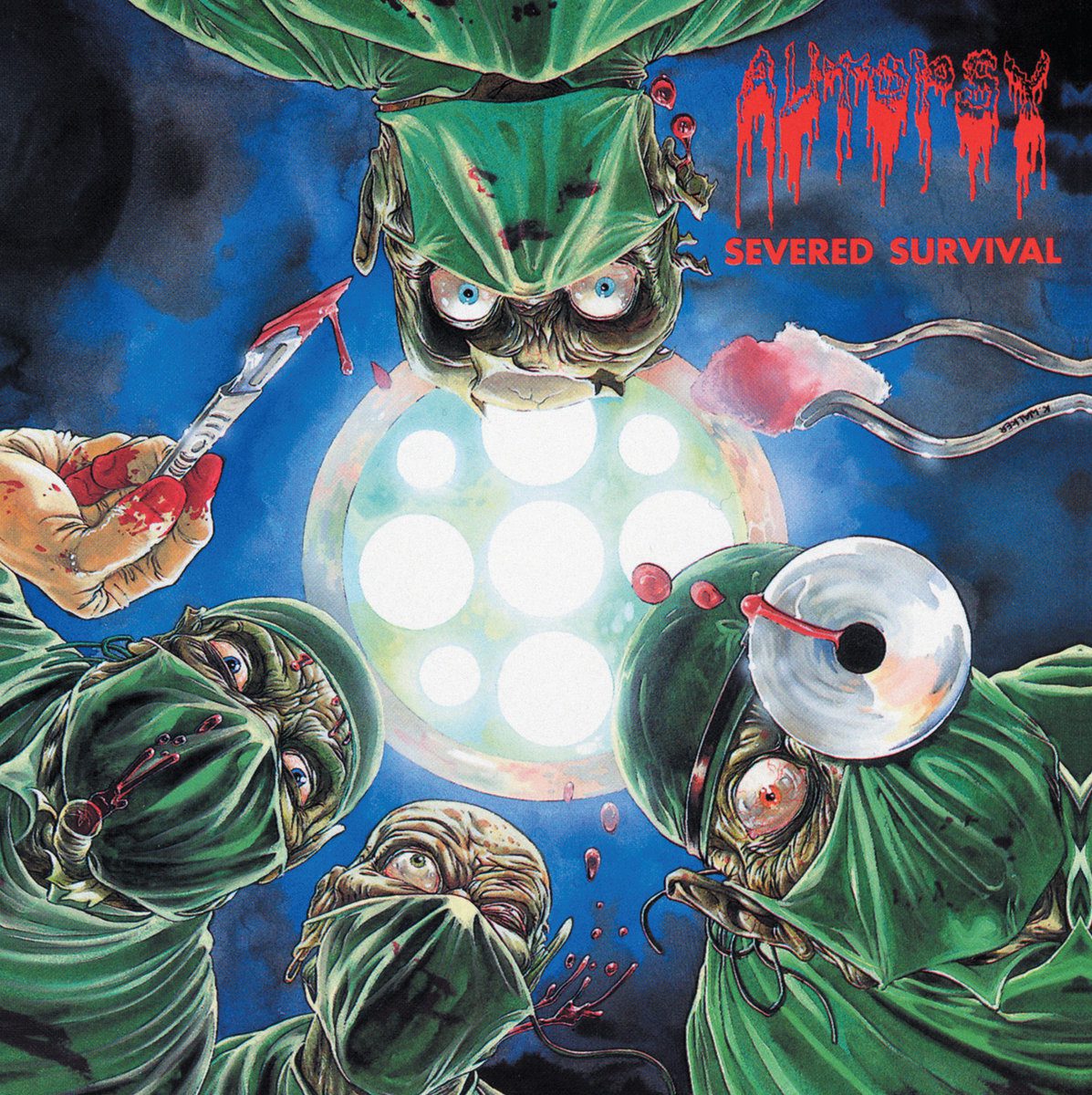

There are two covers to Severed Survival. One by Kent Mathieu. The other by Kev Walker. What’s the story there?
Coralles: The first one ate the second one, or was it the other way around?
Cutler: Good question! The answer is “Why not?” It was probably a publicity stunt by Peaceville Records. “Oh look, this cover was banned, it’s brutal, here is another cover!” [Laughs]
Reifert: There were some distributors who didn’t want to carry the original cover. It’s pretty tame by today’s standards, but it was kind of shocking for some people back then, I guess. We could have probably just forged on with it, but Peaceville asked us how we felt about getting an alternate cover done. That seemed like a cool idea. More killer art! Now that record is pretty well-known for both covers, so it worked out nicely.
Both work in the context of the music and lyrics, but did you ever favor one cover over the other?
Cutler: I always loved them both and felt privileged to have them both.
Coralles: Sure, maybe, but I dare not say.
Reifert: I agree with Eric and Danny!
What were gigs in the U.S. like back then?
Reifert: We always gave it our best, no matter what. We had some good ones, but plenty with hardly anyone there also. Fuck it, we were never trying to win a popularity contest, so we kept rockin’ for better or worse. The parties we used to play in the earliest days should have been filmed. Those things got way out of hand and berserk!
Coralles: Well, everyone was younger. It was a fresh new genre that we were on the cutting edge of, so that was cool. Most of the gigs were great, but there’s always the ones where you drink more than you make, or there’s 10 people in the crowd, but you play like it sold out and soldier on!
Cutler: Most of the time you had to wonder if they charged the dog admission!
You also hit the road with Pestilence, Bolt Thrower and Morgoth in Europe. And then a second time with Paradise Lost. Any specific memories of your European tours?
Cutler: Madness! Look, what’s that over there? It’s a windmill! Lots of good times. The power of the music each night was phenomenal. Such a killer lineup. You don’t see tours like this anymore. We all got along so well we became friends for life. Except for that one guy. Fuck him!
Coralles: Are you kidding me? Way too much to list here. Those were some of the funnest times of my life! Cheese rolls, windmills and happy drunken people!
Reifert: That shit was fun as fuck! We never made any money. We actually got ripped off, but somehow that didn’t dampen the mood. We had great gigs and lots of laughs. Like Danny said: way too many memories to fit here. It was total rock and roll metal mayhem all the way! We actually got to play with Bolt Thrower and Benediction again recently and it was just as much of a blast as before!
What was the feedback like? I remember people were surprised that Autopsy wasn’t all fast. You had slow, doomy parts, a first of their kind in death metal.
Cutler: The turnout was good every show. The crowds loved all the bands. I think the slow doomy parts went over really well. Playing that style live gives people a chance to take in the heaviness. Let it consume you! You are now powerless!
Reifert: We went over really damn good on that tour. Killer crowds, killer fans, killer bands and lots of beer! It felt like victory.
Coralles: Fuck people!
Did you ever think Autopsy would be so influential?
Coralles: Well, the plan was to dominate the entire planet. Then, we go crush the aliens with the power of metal. So, yeah.
Cutler: Hell no! We just want to enjoy what we do and if others like it then that’s great.
Reifert: I’m always looking forward to the next thing, so I don’t really think about stuff like that. But thanks to anyone kooky enough to like what we do. Big, ugly cheers for that!
DiGiorgio: Looking back on how the band hit the world is kind of interesting. It was Chris’ rebound. It was serious, but it wasn’t that serious. They never took themselves seriously. No one knew how it was going to turn out. It’s cool the cult following they’ve developed. It’s a project that started in a garage with the fluorescent light blinking in the background if you know what I mean. Somehow, it just grew.
Is there anything you’d change about Severed Survival?
Coralles: Well, it’s way too late for that, isn’t it?
Reifert: You have to change sides if you’re listening to it on a record or a cassette tape.
Cutler: No, you can’t think that way. It is great the way it is. No looking back. Well, maybe add a cover song or two. Maybe a little Leo Sayer! Thanks for reading this rubbish!
DiGiorgio: If you would’ve asked me the day after we recorded it I would’ve told you a bunch of things. [Laughs] I remember, I showed up to record. They had everything already set up. I was going to change my strings and they said, “Why?!” I was like, “This is a fucking album recording!” They were like, “Nah, just play with what you got on there.” I ended up putting on the new strings, but they didn’t understand. [Laughs]
—
Now avoid the impending dread of missing out seeing Autopsy perform Severed Survival in full and get tickets to Metal & Beer Fest: Denver now. Daily lineups and ticket info below:
DECEMBER 5 (Pre-fest at Ratio Beerworks)
Green Druid
Abrams
Ghosts of Glaciers
DECEMBER 6 (at Summit)
Autopsy “Severed Survival” set
Frozen Soul
Undergang
Dreadnought
Necropanther
Upon Stone
Daeva
DECEMBER 7 (at Summit)
Yob
Cirith Ungol
Pallbearer
Crypt Sermon
Earthburner
Glacial Tomb
Oak, Ash & Thorn


“Just Metal” Ticket (21+)
Admittance to the day’s event, but as the name suggests, you just get to see the show—no beer samples (You can still buy select beers a la carte if you’re 21+).
“Metal & Beer” Ticket (21+)
Admittance to the day’s event plus unlimited* sampling from our diverse lineup of national breweries presented by 3 Floyds. Decibel Magazine Metal & Beer Fest: Denver 2024 sampling cups provided. Limited tickets available per day.
*Please note: In extremely extreme cases, certain high-ABV pours will be ticketed, with attendees receiving a limited number of tickets available to redeem for each offering.
